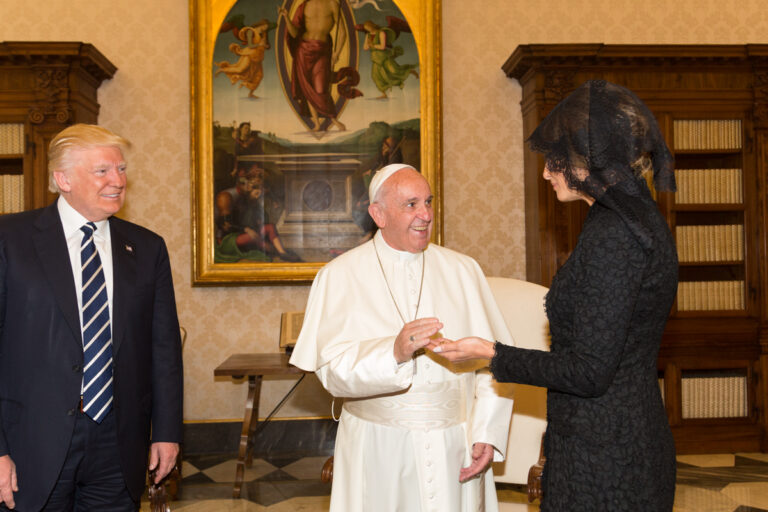
The Push Away From Religion and the Pull Toward Secularity: The Rise of the Nones in the US
Jesse M. Smith and Ryan T. Cragun
Image by Michael Kastelic from Pixabay.
The following essays are reprinted and adapted on Canopy Forum in collaboration with the journal, Australian Journal of Law and Religion, a biannual electronic publication that is free and open access. Read more essays here. You can also read this essay and others in the latest volume of the AJLR (Volume 5) in the Special Topics section.
The rise of the “nones,” or individuals who identify as religiously unaffiliated, represents a monumental shift in the U.S. religious landscape. In our recently published book, Goodbye Religion: The Causes and Consequences of Secularization), we examine this phenomenon, presenting a mixed-methods analysis of how a growing number of Americans are leaving religious organizations and claiming no specific religious identity. We draw on publicly available, nationally representative surveys of the US, as well as 120 in-depth interviews with individuals who have left religion behind. We refer to these study participants as “religious exiters” throughout the book.
The social pressures that demanded religious participation in the U.S. during a significant part of the 20th century have weakened. This has allowed many people to openly admit their disinterest in religion without facing the same social repercussions that would have occurred during the Cold War, when the U.S. was fighting “godless communists” and had constructed an American imaginary that resulted in an environment in which citizens felt obliged to identify as religious, even if they were not. As a result of this cultural shift, no longer having a religious affiliation (such as being a “none”), is rather quotidian and has even become the modal identity in some parts of the country, such as New England and the Pacific states.
One important factor in the rise of the “nones” is generational change. Younger generations are more likely to reject religion than their parents and grandparents. This can be seen in Figure 1, which shows the percentage of each generation that reports no religious affiliation over the last fifty years, using a 3-year average to smooth the data. Every successive generation is less religious than the previous one. Younger generations are exposed to a wider range of worldviews, facilitated by the internet and increased global interconnectedness, which has made religious pluralism and nonreligious perspectives more accessible and acceptable. Moreover, many Americans no longer believe religion is the only source of moral guidance or community. For them, reasons to be and do good are independent of religious claims. They find community in the many different facets of secular society.
In our book, we propose a detailed theoretical framework for understanding why people are leaving religion, primarily through the lens of “push” and “pull” factors. This model is inspired by the approach used in migration studies, where individuals are seen as being “pushed” from their current circumstances while being simultaneously “pulled” by the attractions of a new environment. In the context of religious exiting, push factors are those that drive people away from religious institutions, while pull factors are what draw them toward a secular or nonreligious life.
Push Factors
Push factors refer to aspects of religion that create dissatisfaction or distress, prompting individuals to leave. One of the most important push factors is the moral teachings of religious institutions. Many people feel alienated by doctrines that appear to be outdated or oppressive, especially around issues of gender, sexuality, the family, and social justice. For example, religious opposition to same-sex marriage, gender equality, and women’s reproductive rights clashes with modern values. Figure 2 illustrates very different perspectives regarding homosexuality, comparing those who have left religion with those who are still religious. A large majority of people who have left religion, 79%, do not think homosexual sex is wrong at all, compared to just 45% of those who are religious. Almost the same percentage of religious individuals, 44%, think homosexual sex is always wrong as think it is not wrong at all. Our book provides many additional examples of these differences between religious and nonreligious individuals. Importantly, we recognize that it is difficult to make strong causal arguments with such data, as we do not have participants’ perspectives on these topics before and after they left religion. Even so, the differences are striking and show that moral dissonance may be a powerful force pushing people away from organized religion.
Hypocrisy within religious communities is another push factor. Many of our interviewees cited the contradiction between religious teachings and the behavior of religious leaders or fellow congregants as a major reason for leaving. Religious scandals involving financial corruption or sexual abuse, coupled with efforts by institutions to cover them up, created a deep sense of disillusionment for many. Many people who leave religion feel that their moral integrity is incompatible with staying in religious environments that tolerate or conceal immoral behavior. As they grew tired of the hypocrisy they saw among the religious, our participants became increasingly frustrated and motivated to leave. For example, Liv, a sixty-two-year-old woman we interviewed, described part of the reason she decided to leave the Catholic Church after decades of adherence:
I think one of the things was the more that I went to church and got to know about other people that were going to church, especially people acting holier than thou, being on the front pew of the church and acting so religious, and going to confession, and going and getting communion, and all this. And then I [find out] they were having affairs or they were cheating on this or that, or just doing all these things is…(pause) How hypocritical is that!?
Religious doctrines themselves can be a source of discontent, pushing people out of religion. Theological teachings that conflict with modern scientific findings, like believing the Earth is thousands instead of billions of years old, claims of a worldwide flood, or that humans were created in their present form raise serious concerns for those who embrace evidence-based worldviews. Education and exposure to scientific thinking make it hard to reconcile religious claims with compelling modern understandings of the natural world, leading many to abandon religious beliefs altogether.
Finally, political alignment within religious institutions serves as a push factor for many people. Some religious organizations have aligned themselves with specific political ideologies, particularly conservative ones, which alienates members whose personal political beliefs differ. This religio-political alignment becomes a barrier for individuals who find themselves increasingly out of step with the political stances taken by their religious communities.
Pull Factors
In contrast to the forces that push people out of religion, pull factors attract individuals toward a nonreligious or secular life. One significant pull factor is the intellectual and personal freedom and autonomy that comes with leaving religion. Many people who leave religious institutions express a sense of relief at being freed from the dogmatic obligations that once governed their lives. For example, instead of spending time attending religious services or adhering to strict and arbitrary moral codes, they find themselves with more time and freedom to engage in activities that they find personally fulfilling, such as spending time with family, pursuing hobbies, or focusing on their careers and other obligations. Many religious exiters connect this freedom to morality and the notion of authenticity; they can “be good” and better connect with their authentic selves having left religion. Here’s how Fatima, a woman in her late fifties who left the Lutheran Church and her Christian faith put it:
Well, there’s no requirement. There’s no dogma I have to suck up to now, for you know, “We believe this!” And then there’s the piece of authenticity…I think that the more we connect with our own authenticity (pause), I do believe in the goodness that is inherent in every person, and the more that we connect with our authentic selves, the more we are good and moral people.
Exiting religion offers individuals the ability to construct their own moral frameworks without the constraints of religious doctrines. This is particularly appealing to religious exiters who value autonomy and authenticity. As our book points out, many former religious adherents find that they are more morally consistent and intellectually fulfilled once they leave religion. They no longer feel the need to defend religious teachings they do not fully believe in, and they are able to embrace a worldview that aligns more closely with their personal values and experiences.
This overlaps with another key pull factor, which is the appeal of a modern, evidence-based worldview. Individuals who leave religion often cite the intellectual satisfaction that comes with accepting scientific explanations for the world. This is especially true for those who struggled to reconcile religious teachings with scientific knowledge during their time within religious communities. The embrace of reason, logic, and empirical evidence becomes a strong draw for those seeking a more coherent and consistent understanding of reality. Far from becoming dispassionate materialists, many religious exiters find a modern, evidence-based worldview not only persuasive, but emotionally resonant and inspiring in ways they find motivating. As one religious exiter asserts:
People are afraid that if they lose [religion] then they’ll lose that sense of wonder and mystery and awe that you feel. I remember when I was going to church there is a sense of awe that you feel in ritualized spaces with the chanting and the stained glass windows and the guys in the robes…the whole thing creates that sense of something bigger than you. I think people are afraid if they leave religion they are going to lose that. But I’ve refound [this] through science and physics and astrophysics in particular. I’m a big fan of Neil deGrasse Tyson and you know the phrase “we are star stuff” is what gives me that sense of awe and wonder. When I think of the iron in my body that was once a dying star and the bigness of the universe and our smallness in it gives me that sense of awe and wonder and I think it gives me a more purposeful drive to do good in the world that I live in because we don’t really know what else is out there…I think if you don’t believe in heaven or hell or paradise…then you need to feel responsible to make the world we are in now a little closer to that paradise.
Importantly, the social environment outside of religious institutions is increasingly welcoming and supportive of people who have left religion and embrace secular identities and worldviews. The stigma associated with being nonreligious has diminished significantly, and many individuals find that they no longer face social pressure to conform to religious expectations. This broader societal acceptance makes it easier for people to leave their religious communities without fear of social ostracism or of losing meaning and purpose in their lives.
Conclusion
The push and pull framework in Goodbye Religion helps explain the complex dynamics at play in religious exiting. Many people are driven away from religion by a variety of factors, including moral disagreements, hypocrisy, doctrinal conflicts, and political (mis)alignment. At the same time, they are drawn to secular life by the promise of autonomy, intellectual freedom, not having to defend religious dogmas, and a set of beliefs consonant with a modern, evidence-based worldview. These forces, both individual and societal, are reshaping the religious environment in the United States, contributing to the growing number of people who identify with the “nones” – many of whom affirm positive secular identities. Our framework illustrates that leaving religion is not a single-cause phenomenon but rather the result of multiple, interrelated push and pull factors that are part of a dynamic (non)religious landscape. ♦

Ryan T. Cragun is professor of empirical sociology at The University of Tampa. His research focuses on the nonreligious and Mormonism and has been published in various scholarly journals. He is also the author of several books.

Jesse M. Smith is associate professor of sociology at Western Michigan University. His research focuses on secularity and social deviance, and he has published in a variety of scholarly journals and co-edited a book.
Recommended Citation
Smith, Jesse M. and Ryan T. Cragun. “The Push Away From Religion and the Pull Toward Secularity: The Rise of the Nones in the US.” Canopy Forum, February 4, 2025. https://canopyforum.org/2025/02/04/the-push-away-from-religion-and-the-pull-toward-secularity-the-rise-of-the-nones-in-the-us/.
Recent Posts










